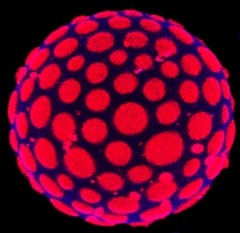Articles and reports from the Life Sciences and chemistry area deal with applied and basic research into modern biology, chemistry and human medicine.
Valuable information can be found on a range of life sciences fields including bacteriology, biochemistry, bionics, bioinformatics, biophysics, biotechnology, genetics, geobotany, human biology, marine biology, microbiology, molecular biology, cellular biology, zoology, bioinorganic chemistry, microchemistry and environmental chemistry.

By using a laser microscope to spy on individual nerve cells in living mice, researchers have discovered that neurons’ wiring remain largely stable, providing a solid scaffold to accommodate the challenges in their environment. Specifically, the scientists found that the neuronal branches called “dendrites” remain largely unchanged in the highly active olfactory processing region of the mouse brain. Such evidence suggest that dendrites in the adult brain form a stable background even in the face

Cell membranes — the sacs encompassing the body’s living matter — can assume a variety of shapes as they morph to engulf materials, expel others and assemble themselves into tissues.
In the past it was possible for theoreticians only to analyze the thermodynamic forces behind membrane shape-shifting. But now a team of biophysicists from Cornell University, the National Institutes of Health and the W.M. Keck Foundation has been able to watch the sacs, or vesicles, reshaping themselves

A research team led by scientists at the Stowers Institute for Medical Research have discovered the location in mice where hematopoietic stem cells (HSCs) reside, often called the HSCs’ microenvironment or “niche.” The team also identified mechanisms involved in controlling the size of the niche and the number of adult HSCs the body produces. This research has solved the puzzle of the hematopoietic stem cell niche first articulated more than 25 years ago and has defined its essential features in

NIH-funded researchers have identified a gene that appears to be a crucial signal for the beginning of puberty in human beings as well as in mice. Without a functioning copy of the gene, both humans and mice appear to be unable to enter puberty normally. The newly identified gene, known as GPR54, also appears necessary for normal reproductive functioning in human beings.
The study, funded in part by the National Institute of Child Health and Human Development (NICHD), appears in the October

Scientists at the University of Michigan Comprehensive Cancer Center have identified a gene that controls the amazing ability of adult stem cells to self-renew, or make new copies of themselves, throughout life.
In a series of extensive cell culture and animal studies, U-M scientists discovered that a gene called Bmi-1 was required for self-renewal in two types of adult stem cells – neural stem cells from the central nervous system and neural crest stem cells from the peripheral nervous sys

For more than a century, biologists have been working to assign plants, animals and microbes their respective places on the tree of life. More recently, by comparing DNA sequences from a few genes per species, scientists have been trying to construct a grand tree of life that accurately portrays the course of life on Earth, and shows how all organisms are related, one to another.
However, despite the detailed insights provided by individual genes, that approach has proved cumbersome in its